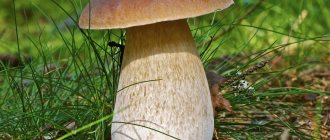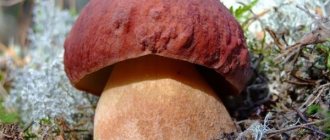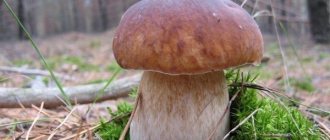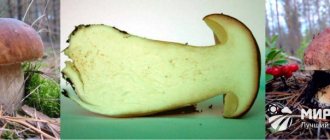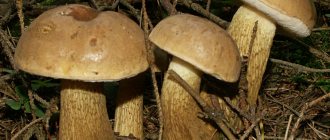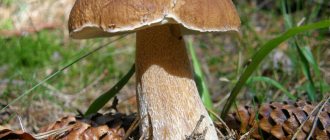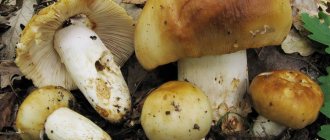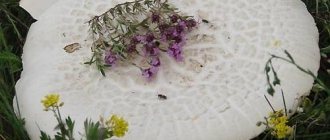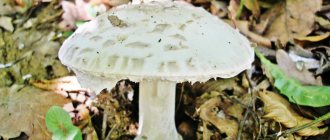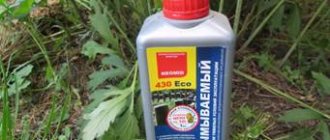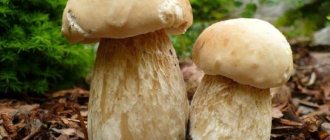Related species
The white oak mushroom has many relatives: the genus boletus or boletus is quite numerous and, in addition to the species of white oak mushroom, includes about 300 species, among which there are both edible, conditionally edible, and inedible (non-toxic), toxic and poisonous.
Edible species include:
- maiden boletus (brown-yellow boletus) – Boletus appendiculatus;
- bicolor boletus – Boletus bicolor;
- Burroughs boletus – Boletus barrowsii;
- Fechtner's boletus – Boletus fechtneri;
- semi-white mushroom (yellow boletus) – Boletus impolitus;
- yellow boletus (yellow boletus) – Boletus junquilleus, etc.
The group of inedible, toxic and poisonous species includes:
- beautiful boletus (beautiful boletus) – Boletus calopus – inedible;
- Boletus porosporus (Boletus porosporus) – inedible;
- purple boletus (pink-purple boletus) – Boletus purpureus – inedible;
- legal boletus – Boletus legaliae – toxic;
- beautiful boletus - Boletus pulcherrimus - toxic;
- satanic mushroom – Boletus satanas – toxic, etc.
Interesting Facts
Boletus reticulatus.
Boletus mushrooms are widely known not only for their excellent taste; you can also find a number of interesting information about them:
- Porcini mushrooms can grow to incredible sizes (the largest recorded white mushroom is 58 cm in diameter and 10 kg in weight).
- White oak mushrooms have been used since ancient times to treat skin and lung diseases.
- Boletus mushrooms tend to enhance the secretion of gastric juice, thus helping to improve the digestion of food. Moreover, this ability is no less pronounced in whites than in meat broths.
- It is currently believed that porcini mushrooms have anti-carcinogenic properties.
As can be seen from the list above, eating boletus mushrooms (as well as all porcini mushrooms in general) is extremely useful.
We must remember that mushrooms are not indicated for children, allergy sufferers and people with chronic digestive disorders.
Similar species and false look-alikes
During a “silent hunt”, the ability to recognize each individual type of mushroom and distinguish it from similar edible species is of great importance. But the most important thing is to learn to distinguish it from inedible and poisonous mushrooms that are similar in appearance, which can harm not only health, but sometimes even human life.
Similar edible species
The porcini oak mushroom has a colorful and quite remarkable appearance and there are not many mushrooms with which it can be confused when collected. First of all, these are the closest related species of oak porcini mushroom - a variety of porcini mushroom (Boletus edulis). From this group, a typical form should be distinguished - the spruce porcini mushroom, which, in comparison with the oak porcini mushroom:
- The surface of the cap is tuberculate.
- The color of the cap is darker - dark brown, brown with a reddish tint.
- It grows in spruce and fir forests, while the white oak mushroom forms mycorrhiza exclusively with deciduous tree species.
Information! Fruiting season for spruce porcini mushroom: June-October.
Also, the oak porcini mushroom has a great external resemblance to the pine and birch porcini mushrooms.
Since these mushrooms are edible and have high taste, there will be nothing wrong if, when collected, they end up in the basket with the white oak mushroom. Studying the differences between one species and another is of interest to those interested in the world of mushrooms.
Inedible look-alikes
Fortunately, the white oak mushroom does not have poisonous or toxic counterparts, which, if consumed, can cause serious harm to human health and life. Inexperienced mushroom pickers sometimes confuse it with the gall mushroom (Tylopilus felleus) from the genus Tylopilus of the Boletaceae family. Other names: false porcini mushroom, false boletus, bitterling.
The mushroom is not poisonous, but it is also not suitable for food, since the taste of its pulp is very unpleasant, bitter, acrid, and does not disappear when cooked, but only intensifies. Even a small piece of a false porcini mushroom can ruin the entire mushroom dish or preparation.
Important! One of the main signs that makes it possible to distinguish the oak porcini mushroom from its dangerous counterparts, inedible and poisonous, is that its flesh does not change color when cut, broken, pressed, or during any type of culinary processing; it always remains white.
How to distinguish white oak mushroom
The gall fungus has the following characteristic features:
- The hymenophore (lower part of the cap) is white in very young specimens, then as it grows it becomes pinkish, dirty pink. Turns red when pressed.
- The leg is covered with a dark-colored mesh pattern, while in the white oak mushroom the mesh is whitish in the upper part and brownish in the lower part.
- The pulp is white; when cut, it changes color to pink, pink-brown, or reddish.
- The taste is bitter.
- It can grow on the roots of not only living trees, but also near rotten stumps and on rotten wood.
- There are no insects on the surface, as they are not attracted to its bitter taste.
Information! The gall mushroom bears fruit from June to October.
Option II
Part No. 1
Select only one and write down its number on the answer form.
- The population of the fungal kingdom is a) 10 thousand species b) 50 thousand species c) 100 thousand species d) 1 million species.
- The fruiting bodies of mushrooms produce a) seeds b) spores c) gametes d) nutrients.
- Select the number of the picture depicting yeast.
№1
№2
№3
№4
- The mycelium in fungi can be a) mononuclear unicellular b) mononuclear multicellular c) multinucleate unicellular d) all answers are correct.
- Unicellular mycelium and spherical sporangia in the fungus a) mucor b) yeast c) penicillium d) smut.
- A person obtains bread, beer, and wine with the help of the fungus a) tinder fungus b) mucor c) penicillium d) yeast.
- is not typical for mushrooms : a) seeds b) spores c) vegetatively (pieces of mycelium) d) sexually.
- Potatoes and tomatoes are parasitized by the fungus a) ergot b) late blight c) smut d) tinder fungus
- An edible mushroom is a) fly agaric b) milk mushroom c) toadstool d) false honey fungus
Part No. 2
Choose three correct answers out of six.
- Select the characteristics common to fungi and animals. a) the cells have a dense shell b) they feed only on ready-made organic substances c) they grow all their lives d) nutrients are absorbed by the entire surface of the mycelium e) the cells do not have pigments f) the cell membranes consist of chitin.
- Select examples of the importance of mushrooms in human life a) cause diseases of the skin, hair, nails b) spoil food c) participate in the formation of humus d) form symbiosis with trees e) participate in the cycle of substances f) are a source of medicinal substances
- Select the names of saprophyte mushrooms a) boletus b) butterfly c) mucor d) russula e) yeast f) boletus
Part No. 3
Match the numbers in the picture with the names of the parts of the mushroom and make labels for the picture. Briefly formulate the rules for collecting mushrooms.
Part No. 4
Complete the sentences with the given words.
- Mycelium penicillium..., in contrast to mucor, which has mycelium....
- Penicillium spores ripen in paniculate spores, and in mucor spores ripen in spherical ones... .
- From penicillium spores, a person receives a medicinal substance that kills bacteria...
Words to supplement the text: mycelium, fungal root, unicellular, multicellular, sporangia, antibiotic, lichen.
Part No. 5
Explain what the picture represents? What type of nutrition does this mushroom belong to? What is formed when mycelium threads sprout from the root of a tree? What does this connection mean for the mushroom and the tree? Solve the situation: for lunch there were boiled mushrooms. Your friend has a stomach ache, has a fever and is feeling nauseous. Your actions?
Part No. 6 Practical work
Using a microscope, determine the type of fungus on a microscopic specimen. Tell your teacher the result.
Botanical description
hat
The cap of the white oak mushroom is round, thick, and fleshy. In young mushrooms it is hemispherical; as it grows, it gradually opens up and becomes strongly convex and finally cushion-shaped in older specimens.
The surface is smooth or wrinkled. The skin of the white oak mushroom is dry, matte, initially thin-velvety, then bald. In dry weather and in old mushrooms, it is often covered with a network of deep cracks.
The color at a young age is light shades: grayish, ocher-gray, grayish-brown, light, yellowish-brown, coffee, light brown. Sometimes it gets darker with age. The surface may also be covered with lighter spots.
Diameter: 6-20, up to 30 cm.
Hymenophore
The hymenophore of the white oak mushroom (the lower part of the cap) - the tubes are thin, short, tightly connected to each other. At first they are notched, but in mature mushrooms they are lagging behind. Thickness of the tubular layer of oak porcini mushroom: 1-3.5 cm. The pores are small, round.
The color of both the tubes and the pores of the porcini mushroom is white in young specimens, then changes to greenish-yellow and finally olive-brown in old age.
The spores are fusiform and smooth. Color: honey yellow. Size: 13-20 x 4-6 microns. Color of white oak mushroom spore powder: olive-brown, olive-brown.
Leg
The leg is central, massive, strong, solid. In young mushrooms it is barrel-shaped, then as it grows it becomes club-shaped and cylindrical.
It is pubescent at the base. The color is lighter than the caps - light coffee, light brown, light brown. The entire surface is covered with a large mesh pattern, the color of which is whitish in the upper part and brownish in the lower part.
Height of the leg of the white oak mushroom: 4-15, up to 25 cm, diameter: 2-8 cm.
Pulp
The pulp is thick, fleshy, dense, does not crumble. The color is white, under the tubes of the white oak mushroom it can be yellowish. Does not change when cut or damaged. Taste: nutty, sweetish. Smell: pronounced, pleasant mushroom.
Growing porcini mushrooms in a personal plot: planting mycelium
In the photo, growing porcini mushrooms on a personal plot
There are several ways to plant porcini mushroom mycelium. In the first method, overripe porcini mushrooms are collected and filled with rainwater in a wooden bowl. This mixture is left for a day. Then mix well and filter through a fine cloth. As a result of this procedure, a lot of porcini mushroom spores remain in the water. They settle to the bottom. To germinate them, you can add a little baker's yeast to the water. Then carefully remove the foam with a spoon and drain the upper part of the clear liquid, and place the remaining part of the solution with spores in the light. You can drain the remaining liquids from different containers into one. After a week, the upper part of the clear liquid is carefully drained, and the settled suspension is poured into bottles and stored in the refrigerator. This suspension can be used for a whole year, but it is better to use it during the first month, since it is during this time that the spores retain their viability. Water the prepared bed with this mixture, and first remove the top layer of soil.
You can also water the mixture around the selected trees. First, carefully remove the layer of soil without damaging the tree roots. This is done in order to expose the roots of the trees. Then water them with the suspension and cover them again with earth. Pour the suspension at the rate of 400 g for every 30 cm2. After which the soil should be watered generously with 4–5 buckets of water.
In the second method of growing porcini mushrooms in the country, the mycelium is harvested in places where porcini mushrooms grow. Why, around the mushroom, layers of soil measuring 20 X 30 cm and a thickness of 10–15 cm are cut out. Then they are cut into several parts and planted in a bed or in a chosen place so that there is a layer of earth 5–7 cm thick above them. The beds are then moisten a little and cover with leaves and shields so that they are always moist.
Porcini mushrooms should be sown under the same trees under which the planting material was taken. It has been noticed that boletus mushrooms grow better under trees that are 15–25 years old.
You can sow mycelium in another way. Why overripe porcini mushroom caps are cut into small pieces and mixed with a small amount of soil. Then moisten it a little. You can also sow slightly dried mushroom caps. They are laid out on a bed and watered with water. After 5-6 days they are removed - the spores along with water have already penetrated into the soil. You can place pieces of the cap under the top layer of soil.
It is better to sow mycelium in September.
- Author: Tatyana
Rate this article:
- 5
- 4
- 3
- 2
- 1
(2 votes, average: 5 out of 5)
Share with your friends!
Habitat
Oak porcini mushroom - although a widespread species, is not as common as other varieties of porcini mushroom. It grows in temperate climate zones, but gravitates to the south. Most often the habitat regions are mountainous or hilly areas.
The white oak mushroom has become widespread in North America, Eurasia, and North Africa. In the CIS - these are the temperate climate regions of the European part, as well as Crimea, Krasnodar Territory, Transcaucasia, etc.
Prefers dry alkaline soils. Grows in small groups or singly.
Where does the porcini mushroom grow?
This species forms mycorrhiza (symbiosis with the roots of the plant) with deciduous trees: oak, beech, hornbeam, linden, edible chestnut.
Many, especially beginners, mushroom pickers are interested in where to collect white oak mushroom. The mushroom grows in light deciduous and broad-leaved, less often mixed forests.
Information! The white oak mushroom grows on the roots of oak, beech, hornbeam, linden, and edible chestnut.
Fungus smut
The fungus smut mainly affects cereals. It settles in the flower when it is already fertilized and a small grain rich in nutrients has appeared. At first the plant looks healthy, because the smut attacks the internal tissues, but by the time the grain is supposed to ripen, black smut spores appear in the ear instead. The plant looks like a charred firebrand, which is why the mushroom got its name.
Fungus smut
How to collect
The white oak mushroom is the earliest representative of the porcini mushrooms and begins to bear fruit in early May. And until the first autumn frosts (late October), these mushrooms can be collected. Forms so-called layers or waves of fruiting. Peak yield occurs at the end of August - beginning of September.
Information! The fruiting season of the oak porcini mushroom: early May - late October.
The most favorable conditions for the appearance of white oak fungus are warm weather with sufficient, but not excessive humidity. Therefore, during warm night fogs, as well as after a short summer rain, you can safely go into the forest for these wonderful mushrooms.
Conversely, significant amounts of precipitation and large differences in day and night temperatures hinder growth.
Attention! The white oak fungus does not grow on waterlogged soils, swamps and peat bogs.
This species is photophilous and prefers light forests and sufficiently illuminated sunny areas. It should be looked for, first of all, along forest paths, clearings, in clearings, and forest edges.
At the same time, the white oak mushroom (reticulated boletus) likes to hide in the grass, under the leaves. Therefore, mushroom pickers should be attentive and patient and look closely at each bump, because underneath it there may be a delicious, handsome porcini mushroom hiding.
Often found in the vicinity of the yellow oak (Boletus erythropus).
Important! The optimal age of oak porcini mushroom for collection can be determined by the shape of the cap: in young specimens it is hemispherical, strongly convex, in older specimens it is cushion-shaped. Also when young, the tubular layer is white, which then changes to greenish-yellow, olive-brown.
Young specimens with a cap diameter not exceeding 7 cm, which have hard, dense, tender pulp, are suitable for collecting oak porcini mushroom. The pulp of old white oak mushrooms is soft, spongy, and the taste also suffers. Also, more mature mushrooms are more susceptible to rotting and mold.
Information! The advantages of oak porcini mushroom include the fact that it is extremely rarely affected by pests.
Although this mushroom is quite rarely wormy, it would not be amiss to carry out a preliminary inspection even at the collection stage. Usually the worms start eating the fruiting body from the base of the stem, so you should carefully examine the cut of the white oak stem mushroom.
Important! Mushrooms tend to accumulate all kinds of toxins and heavy metals from the soil. Therefore, to collect oak porcini mushrooms, you need to choose environmentally friendly places, away from industrial enterprises, roads, etc.
Where does it grow and when to collect Boletus reticulum?
The most active growth of mushrooms can be seen in clearings illuminated by the sun and in deciduous forests.
The reticulated boletus loves the sun's rays.
Loves deciduous and mixed forests. Can often be found on the edges of the forest.
Very often included in mycorrhiza with beech, oak and hornbeam.
It is most common in the Belgorod region, Crimea, Stavropol and Krasnodar territories. Found in the Caspian region.
It actively bears fruit from May to October, however, you need to take into account the unique climatic conditions of the individual zone of your residence.
How to process
Porcini oak mushroom, like most mushrooms, is a perishable product and must be processed no later than within 24 hours after collection. You can extend the shelf life somewhat by placing the mushrooms in the refrigerator.
If plastic bags were used for collection, then in any case the mushrooms should be poured into baskets, for example, as quickly as possible. It is unacceptable to keep collected mushrooms in closed bags, this reduces storage time and leads to their rapid spoilage.
Important! Already 12 hours after collection, up to 50% of the beneficial substances in the oak porcini mushroom are lost.
The beneficial properties of the oak porcini mushroom include the fact that its pre-culinary processing is minimal: special cleaning, as well as preliminary long-term soaking or boiling, is not required.
Important! Pre-treatment of porcini oak mushrooms intended for drying, freezing, and canning is somewhat different from the general scheme.
The general scheme of pre-culinary processing of white oak mushroom is as follows:
- The mushrooms are sorted out and carefully examined, removing forest debris and discarding old, suspicious, and also specimens severely damaged by worms and rot.
- Then the fruiting bodies are wiped with a soft brush or rag to remove forest debris and dirt adhering to them. Use a sharp knife to scrape off stubborn dirt and cut out areas affected by rot and pests. The lower part of the leg is also cut off.
- At the next stage, the white oak mushrooms are washed. To do this, first fill them with water and thoroughly wash each specimen separately, and then all together, changing the water several times.
Next, the mushrooms are soaked in salted water for 15 minutes. After this, the water is drained and the mushrooms are washed well several times, while changing the water. Then put it in a colander and let the water drain.
- After washing, the fruiting bodies are carefully inspected again for the presence of rotten and pest-damaged areas, which are removed.
Rub the entire surface of the mushroom with your hand. If the skin peels off in some place, this is an indicator of spoilage. This skin, as well as part of the pulp under it, is also cut out.
- And finally, the porcini oak mushrooms are washed under running water and placed in a colander to drain.
Advice! Mushrooms intended for cooking can be strained less thoroughly, as they will still be in the water. Porcini mushrooms that are going to be fried or stewed should be kept in a colander for more time.
Ergot fungus
The ergot fungus settles in rye flowers, receives nutrients from them and grows quickly. The fungus secretes sweet drops that attract insects; insects fly to the smell, get dirty in the spores and transfer them to healthy plants. So ergot infects more and more plants. By the time the rye ripens, ergot forms dark horns in the ears, which are called sclerotia.
Ergot fungus
If you grind the grains together with ergot horns and eat bread baked from such flour, you will get severe poisoning. In the Middle Ages, no fewer people died from ergot poisoning than from the plague and cholera.
How to store
Porcini oak mushroom is considered by experts to be one of the most delicious mushrooms. The taste is reminiscent of spruce porcini mushroom, but has a more refined aroma. In its raw form, the taste and aroma are weakly expressed and are revealed during cooking.
Oak porcini mushroom is universal and has shown itself to be excellent in any type of preparation. It is also widely used in canning, both as a mono component and as part of vegetable stews.
The advantages of this type include the fact that with any type of culinary processing, including drying, it retains the original color of the pulp - white, and looks beautiful and appetizing.
The mushroom is especially fragrant when dried. At the same time, this method of harvesting is quite simple and not troublesome and allows you to extend the shelf life of white oak mushroom. There is no need to pre-wash the mushrooms, just clean them properly. The prepared fruiting bodies are strung on a thread and dried in the open air. An oven, oven or electric dryer is also used for these purposes.
Overdried, broken specimens are ground into powder in any convenient way, and then used as an aromatic seasoning in the preparation of soups, sauces, and main courses.
Information! The protein contained in oak porcini mushrooms is most fully absorbed by the body (up to 80%) when consumed in dried form.
Freezing is also a fairly quick and economical way to prepare porcini mushrooms for the winter. The result is a semi-finished product that is immediately ready for basic culinary processing.
Information! Both dried and frozen, the nutritional value of oak porcini mushroom is completely preserved.
Preliminary preparation of mushrooms intended for freezing and drying is similar. An important distinguishing point is that they cannot be washed. Since the pulp of white oak mushrooms absorbs water well, after freezing and subsequent thawing, the mushrooms will become unsuitable for food. Therefore, washing is replaced by wiping the surface of each fruiting body with a damp cloth.
Important! It is unacceptable to wash oak porcini mushrooms intended for drying and freezing.
And, of course, the high taste qualities of oak porcini mushroom are perfectly revealed when salted and pickled. Young specimens are selected for these preparations.
How to plant and how to grow porcini mushrooms in a country house or garden plot (with video)
Boletus has always been considered the king of all mushrooms. It is quite difficult to grow it, since it belongs to the group of mycorrhizal fungi that grow in symbiosis with tree roots. Therefore, the conditions for growing porcini mushrooms should be similar to the conditions under which they live in the wild.
Porcini mushrooms at the dacha photo
Porcini mushrooms in the garden photo
Mushrooms love moderately moist and bright clearings, but not in the open rays of the sun. Boletus will not grow in dark places. Also, the porcini mushroom does not tolerate proximity to some herbs, such as fern and hoofweed. Before growing porcini mushrooms on your property, all these factors should be taken into account.
If you have the appropriate trees in your garden plot, then you can quite easily organize the cultivation of porcini mushroom on a production scale. No one has yet managed to grow this mushroom under artificial conditions, without trees.
Before planting porcini mushrooms in the country, you need to prepare special beds. To do this, a pit 2 m wide and 30 cm deep is dug at the selected site. It is filled with a special mixture, which is prepared in advance. Fallen oak leaves are collected in the spring and mixed with rotten oak wood and clean horse manure. Both oak wood and horse manure should be added to the leaves in a ratio of 5% of their volume. First, lay the leaves in a layer of about 20 cm, sprinkle in a little horse manure and rotten wood and water with a 1% solution of ammonium nitrate.
Then exactly the same new layer is laid. In this way, several layers are performed. After 7-10 days, the mixture should warm up to 40 °C. At this moment it must be mixed so that it becomes a homogeneous mass. After a month, the mixture is ready and it is placed in a pit in the form of layers 10–12 cm thick. Each layer is sprinkled with a layer of garden soil 6–8 cm thick. The entire thickness of the bed is about 50 cm. In the middle it is made higher so that water rolls off it.
When growing porcini mushrooms in a personal plot, the mycelium should not be overfilled with water, it may die; but in dry autumn it should be moistened with a watering can or sprayer. Growing and caring for mycelium involves periodic watering during dry summers. It is advisable to water early in the morning. There is no need to apply mineral fertilizers. Single mushrooms appear the next year after planting, and a good harvest is harvested 2 years after sowing. Under one tree you can get a bucket of harvest. When picking mushrooms, they should be carefully cut off, leaving the remains of the stem so as not to damage the mycelium.
Create a mycelium of porcini mushrooms together with a trusted supplier:
- The porcini mushroom is a boletus mushroom, also known as the royal mushroom. It is known, loved and collected in forests all over the world. Boletus is suitable for all types of processing. At the same time, the mushrooms do not darken, the broth remains clean and transparent after cooking, and when dried, the pieces remain white.
- Pine porcini mushroom is the mycelium (mycelium) of the most noble, aromatic and tasty mushroom for growing on the site. The cap is chocolate brown, powerful, fleshy. The leg is thick, tuberous. Now you don’t have to spend hours searching in the forest for the king of all mushrooms!
- Oak porcini mushroom is one of several varieties of porcini mushroom, or boletus. White is considered the king of mushrooms, because... In terms of protein content, it is practically not inferior to meat. This mushroom got its name - porcini - due to its white pulp that does not darken when cooked and processed.
- White birch mushroom is one of the best mushrooms, among others, the most aromatic when dried. Can be pickled or used fresh. Well, the area should grow birch trees, preferably quite young (4-6 years), but this is not strictly necessary.
In cooking
White oak mushroom belongs to the I, highest category of nutritional value. It has a delicate texture, a recognizable sweetish taste with a light nutty aftertaste inherent in porcini mushrooms, as well as an exquisite subtle mushroom aroma. It is for these characteristics that connoisseurs of mushroom cooking classify the white oak mushroom as a delicacy.
The pulp of the mushroom is thick, fleshy, dense, and does not crumble. During cooking, it retains its shape and texture well and does not fall apart.
It is universal, suitable for all types of culinary processing: it is boiled, fried, stewed. Based on this, there are many recipes for porcini oak mushroom, both hot and cold.
White oak mushroom is used in the preparation of soups, main courses, various appetizers, salads, pates, sauces, and also as a filling for pies, pies, pizza, etc. It has proven itself highly, both as an independent dish and as part of other ingredients. It goes well with both meat and various vegetables, including potatoes, cereals, and pasta.
Information! The product is low-calorie. The calorie content of white oak mushroom is 22-30 kcal per 100 grams. product.
Porcini oak mushroom is one of the mushrooms that can be eaten even raw. Regarding additional pre-cooking processing of raw mushrooms, opinions vary: most authors believe that it is not required. Other experts advise dousing pre-prepared mushrooms with boiling water or blanch them in boiling water for several minutes. The second method is more suitable for people with a sensitive digestive system.
Advice! For people with a sensitive digestive system, white oak mushrooms for use in raw form should be doused with boiling water or blanched in boiling water for several minutes.
In Italian cuisine, raw porcini mushrooms with the addition of Parmesan cheese are used to prepare salads, dressed with olive oil and seasoned with lemon juice and spices.
Literature:
Mikhail Vishnevsky. Mushrooms. Key to mushrooms of Russian forests and fields.
Aurel Dermek. Mushrooms.
Polenov A.B. Mushrooms. Edible and inedible.
Mikhail Vishnevsky. Medicinal mushrooms. Great encyclopedia.
Anna Romanova, Alla Bulatova. Mushrooms. Illustrated guide to collection, processing and storage.
Answer sheet for the final work “The Kingdom of Mushrooms”. Option II
Last name, first name, ________________________________________________________________________________
Part No. 1 Choose one correct answer out of four (9 points)
| Job number | 1 | 2 | 3 | 4 | 5 | 6 | 7 | 8 | 9 |
| Possible answer |
Part No. 2 Choose three correct answers out of six. (6 points)
| Job number | 1 | 2 | 3 |
| Answer options |
Part No. 3 Match the numbers in the picture and the names of the parts of the mushroom. (3 points)
| №1 | №2 | №3 | №4 |
Rules for collecting mushrooms_________________________________________________________________________ _________________________________________________________________________________________ _________________________________________________________________________________________
Part No. 4 Complete the sentences with the suggested words . (3 points).
| OFFER No. | 1 | 2 | 3 |
| Missing word |
Part No. 5 Free-response task. (15 points)
_______________________________________________________________________________________
_______________________________________________________________________________________
_______________________________________________________________________________________
_______________________________________________________________________________________
_______________________________________________________________________________________
_______________________________________________________________________________________
Part No. 6 Practical work (5 points)
Score (to be determined by the teacher)______
Cost of fresh and dry mushrooms
In Russia there are three regional centers where procurement takes place:
- The development of the northwestern center was facilitated by direct investments from Sweden, Finland, and Norway.
- The incentive for the formation of the capital center was the great demand in the Moscow market. Here, several large companies are engaged in the procurement and canning of mushrooms.
- The Siberian center is represented by procurement and processing companies of the Tomsk region, Altai, and Krasnoyarsk Territory.
Important! From April 1, 2022, the item
-
mushrooms.
But in the HS Classifier the rate remained at
18%.
Thus, when importing raw materials
from abroad, it is necessary to pay VAT at a rate of 18%, if sales are carried out within the country, then the VAT rate will be 10%.
In each village rich in mushrooms, 1–2 procurement points are located.
Producers buy products at prices that vary greatly depending on the region. The larger the mushroom harvest, the lower their cost. In Central Russia and the North-West, 1 kg of fresh porcini mushrooms costs 200-300 rubles, in Siberia - 150-250.
The Pskov region, which belongs to the northwestern center, offers for sale frozen porcini mushrooms, cut into cubes, with zero worms, in 25 kg bags. The cost of one kilogram is 315 rubles. — when paying in cash, 343.35 rubles — when paying by bank transfer, excluding VAT. When paying through a bank and paying VAT at the rate of 18%, you need to transfer 355-400 rubles for each kilogram.
Freezing mushrooms allows you to sell them 2-3 years after they are collected. Accordingly, their price will be lower, for example, one kilogram of whole specimens, extra-class, without worms, harvested in 2016 is sold for 445 rubles. without paying VAT.
The “shock” freezing method involves cooling the mushrooms to a temperature of -40°C, then the product is stored in a regular freezer at -18°C. Thawed mushrooms have the nutritional, taste qualities of their original form, they belong to the extra class. The retail price of a kilogram of such products is 0.8–1.1 thousand rubles. , wholesale - 0.65–0.9 thousand rubles.
About
Contraindications and possible harm
The opinion of ecologists and nutritionists around the world is that all mushrooms on planet Earth are inedible due to their ability to absorb toxins and, accordingly, cause severe poisoning when consumed. If you think that the benefits of mushrooms are greater than the harm, it is still better not to take too large and old mushrooms into the basket, as they accumulate many dangerous chemical and radioactive elements. It is recommended to collect boletus away from industrial factories and in forests located away from the highway.
Important! Mushrooms, including boletus mushrooms, are capable of absorbing huge quantities of radioactive cesium and strontium, cadmium, mercury, and lead.
Women should refrain from eating porcini mushrooms during the period of bearing and feeding a child in order to protect the fetus from possible consequences. It is not recommended to include this product in the menu of kindergartens, because the digestive organs of children do not yet produce enzymes with the help of which the chitinous shell of mushrooms is digested. Only from the age of 12 can mushroom delicacies be added to the diet.
They are contraindicated for use in diseases of the digestive organs, kidneys and liver. To minimize possible harm, boletus mushrooms are consumed in small quantities. It is important to know how long to cook fresh boletus mushrooms until they are ready. This process should last 35 minutes. The dried ones are first soaked overnight, or at least for two hours in cold water, and then boiled until they sink to the bottom. Frozen ones are immersed in boiling water and cooked for half an hour.
Mushrooms are characterized by great variability in shape, size, and color. They depend on the composition of the soil, the presence of trees and climate. Every avid mushroom picker knows what a boletus mushroom looks like. The description of a real, false, poisonous porcini mushroom has practical value for novice mushroom pickers, because the forest gift will help heal, replenish the human body with nutrients and allow you to earn good money.
